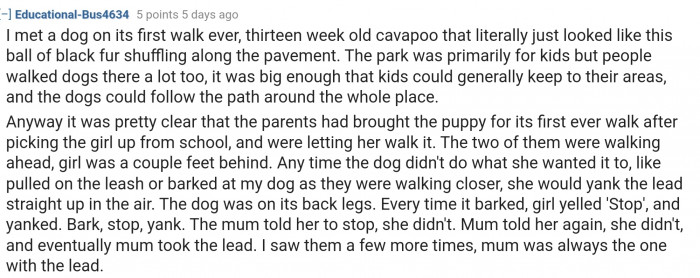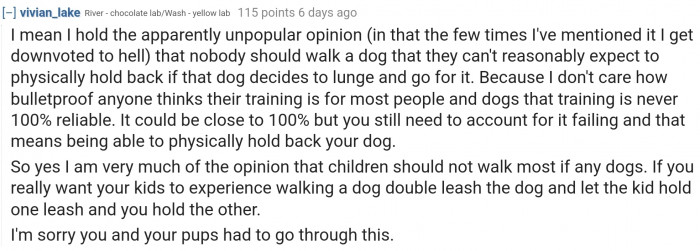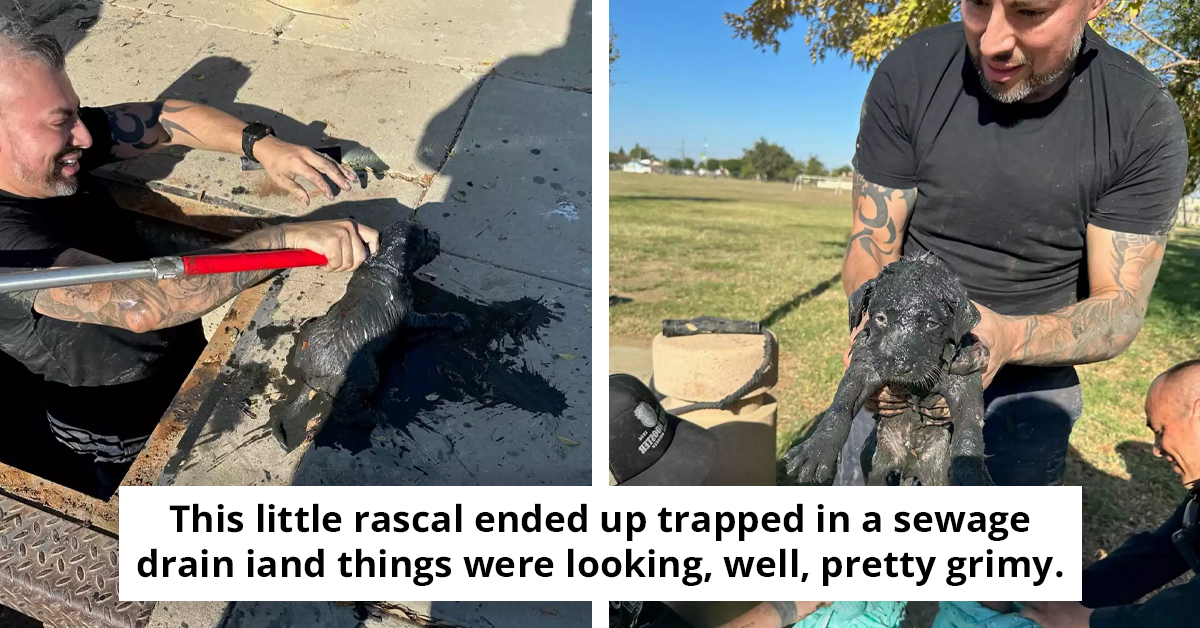After A Terrifying Encounter With A St. Bernard Mix, A Dog Owner Rants And Proves That Little Children Should Never Walk Big Dogs
Kids love big dogs; there's no denying that. But as any parent knows, sometimes those furry friends can be a handful, especially when they're being walked by a little boy or girl.
There are several reasons why children shouldn't walk big dogs. For one, it can be dangerous. A large dog's leash can easily pull a child over, and their size means they can unintentionally knock a smaller person down.
Big dogs also tend to have a lot of energy, which can be overwhelming for a child. They may not be able to keep up with the dog's pace or may tire quickly from all the tugging.
And then there are the messes. Big dogs tend to leave behind large piles of poop, which no child wants to deal with.
So while it may be tempting to let your child walk the family dog, it's best to leave that job to an adult. It's safer for everyone involved, and your child will still get plenty of quality time with their furry friend.
One Redditor recently ranted about a child who couldn't stop the behavior of a St. Bernard mix. The big dog attacked their poor smaller dogs while they were on a walk.
The Redditor was kind enough to pay as dog tax, which people greatly approved.

How the attack happened

The big dog injured the original poster's (OP's) two smaller dogs.

Understanding Aggression in Dogs
The encounter with the St. Bernard mix reflects the complex nature of canine behavior and the factors that drive aggression. According to Dr. John Paul Scott, a noted animal behaviorist, aggression in dogs can stem from fear, territorial instincts, or even a lack of socialization. Understanding these underlying motivations is crucial for dog owners to manage interactions safely.
Moreover, studies show that poorly socialized dogs are more likely to exhibit aggressive behaviors, particularly towards unfamiliar animals or situations. This emphasizes the importance of early and positive social experiences for dogs.
Understanding Dog Behavior and Human Responsibility
The interaction between dogs and humans requires a nuanced understanding of both animal behavior and human responsibility. Research from the Animal Behavior Society shows that larger dog breeds often exhibit different behavioral patterns compared to smaller breeds, which can lead to misunderstandings in social contexts.
When owners do not recognize these differences, it can result in dangerous situations, as seen in the article's scenario.
It's hard to control one's anger, particularly in such a situation. But this pet owner did their best not to get angry so that they wouldn't traumatize the little girl.

People are concerned about the injuries and want to make sure that the OP is taking the necessary precautions.

Good thing some people provided their input regarding the dog bites.

Research in the field of animal behavior emphasizes that aggression can be a learned behavior. According to Dr. Ramani Durvasula, a clinical psychologist, "Dogs that have faced trauma or negative interactions may develop aggressive tendencies as a protective mechanism." This highlights the importance of proper training and socialization to mitigate such behaviors. Furthermore, Dr. Laura Berman, a renowned sex therapist, notes that "dogs often mirror the emotional states of their owners," suggesting that an anxious or fearful owner can escalate tension in their pets.
Furthermore, the fear surrounding large dogs often stems from societal attitudes and personal experiences. Studies indicate that negative encounters with dogs can lead to long-lasting fear and anxiety, not only for people but also for the dogs involved.
This fear can manifest as defensive behavior, which in turn can escalate situations that may otherwise be resolved peacefully.
The situation happens often.
This user also admits that those wounds are quite troublesome to clean. But you have to do what you have to do.

If your dogs have the same injury, remember to clean the wounds thoroughly because infections are likely to occur.

We hope these parents learned their lesson.

Safety Protocols for Dog Owners
To prevent negative encounters, experts recommend that dog owners implement safety protocols during walks and outings. For instance, keeping dogs on leashes in public areas can significantly reduce the risk of aggressive encounters. The Journal of Veterinary Behavior emphasizes the importance of training dogs to respond to commands and to socialize with other pets in controlled environments.
Additionally, owners should consider enrolling their dogs in obedience classes to enhance social skills and reduce aggressive tendencies.
The Importance of Proper Training
Proper training and socialization are vital for ensuring that dogs of all sizes behave appropriately in various situations. Research from the American Kennel Club emphasizes that early socialization can reduce aggressive tendencies and promote positive interactions with other animals and humans.
Owners should prioritize training, which not only benefits the dog but also enhances the safety and comfort of everyone involved.
If only parents thought this way...

Two leashes, one held by an adult and the other held by the child, is always a great idea.

Other people agree.

Another effective approach is to engage in positive reinforcement training, which has been shown to improve behavioral outcomes in dogs. Research indicates that dogs trained using reward-based methods are less likely to exhibit aggressive behaviors. This method not only builds trust between the dog and owner but also fosters a more positive environment for all pets involved.
Ultimately, understanding canine behavior and implementing appropriate training can lead to safer interactions and promote a more harmonious community.
In addition to training, understanding canine body language is crucial for preventing dangerous situations. A study published in the Journal of Veterinary Behavior highlights that many dog bites occur due to misinterpretation of a dog's signals, leading to avoidable conflicts.
Educating owners about canine communication can empower them to manage their dogs more effectively and prevent misunderstandings.
Two leashes are such a great sight to see too.

Some parents are just ignorant.

Children don't have enough experience with things such as dog behavior.

Creating Safe Environments for All
Establishing safe environments for dogs and their surroundings is essential for preventing conflicts. Research published in the Journal of Applied Animal Welfare Science shows that creating dog-friendly spaces can significantly reduce aggressive encounters and enhance overall community well-being.
Communities should consider implementing dog parks and designated areas where dogs can safely interact and socialize.
They're not aware of the harm they could possibly contribute to, so it's important that parents take the lead always.

As a general rule, if people can't physically halt their dogs, they shouldn't be walking their pets around.

Even a teenager can't manage a bolting dog.

Encouraging responsible pet ownership is vital in reducing conflicts between dogs and children. Studies show that educating families about dog behavior and safety can lead to better outcomes for both pets and humans.
By fostering a culture of responsible pet ownership, communities can enhance safety and enjoyment for everyone.
Sometimes, even adults get overpowered by their dogs.

It's not just about the dog being friendly; it's also about how the other dogs would react.

It's scary to go near these dogs.

The Psychological Impact of Fear
The fear experienced by dog owners after an attack can have lasting psychological effects. Research from the American Psychological Association suggests that trauma responses can emerge following such incidents, leading to heightened anxiety and avoidance behaviors.
Addressing these fears through counseling and community support can help individuals overcome trauma and foster healthier relationships with animals.
Though it may seem like a harmless activity, letting children walk big dogs can be dangerous.
They could be injured by the dog, or the dog could injure others. As responsible pet owners, we need to keep our children and animals safe by never putting them in this potentially harmful situation.
Have you ever let your child walk your dog? What was your reasoning behind it?
Additionally, community conversations around dog safety can promote a culture of understanding and empathy. Engaging in open dialogue about pet ownership can help destigmatize large breeds and reduce fear-based reactions.
By fostering a supportive community, individuals can feel empowered to share their experiences and seek help when needed.
Psychological Analysis
This encounter illustrates the critical need for understanding both dog behavior and the responsibilities of ownership. By fostering education and community awareness, we can improve interactions between dogs and humans, ultimately enhancing safety and relationships.
Analysis generated by AI
Analysis & Alternative Approaches
In summary, navigating the complexities of dog ownership requires an understanding of both animal behavior and community dynamics. According to Dr. William Doherty, family therapist, "Building awareness and education around pet safety is essential for fostering healthy relationships within communities." By prioritizing training, responsible ownership, and open communication, individuals can create safer environments for all involved.
Analysis & Alternative Approaches
In conclusion, understanding the motivations behind canine aggression is essential for ensuring safe interactions between dogs and their owners. By employing effective training methods and practicing positive reinforcement, dog owners can mitigate aggressive behaviors and foster better relationships with their pets. The goal is to create a safe and enjoyable environment for all, ultimately leading to more fulfilling experiences in the community.



